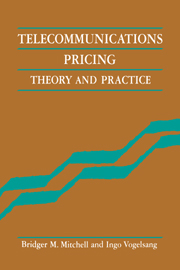Book contents
- Frontmatter
- Contents
- List of figures
- List of tables
- Acknowledgments
- I PRICING AND TELECOMMUNICATIONS
- II RECENT DEVELOPMENTS IN THE NORMATIVE ECONOMIC THEORY OF TARIFFS
- 3 Types of tariffs
- 4 Linear tariffs
- 5 Nonlinear tariffs
- 6 Cost-based tariffs
- III TELEPHONE RATE STRUCTURES IN THE UNITED STATES
- IV SYNTHESIS
- A US telephone price indexes
- Bibliography
- Index
- Selected list of RAND books
4 - Linear tariffs
Published online by Cambridge University Press: 28 October 2009
- Frontmatter
- Contents
- List of figures
- List of tables
- Acknowledgments
- I PRICING AND TELECOMMUNICATIONS
- II RECENT DEVELOPMENTS IN THE NORMATIVE ECONOMIC THEORY OF TARIFFS
- 3 Types of tariffs
- 4 Linear tariffs
- 5 Nonlinear tariffs
- 6 Cost-based tariffs
- III TELEPHONE RATE STRUCTURES IN THE UNITED STATES
- IV SYNTHESIS
- A US telephone price indexes
- Bibliography
- Index
- Selected list of RAND books
Summary
Marginal-cost prices
Feasibility problems
The starting point and benchmark for all public utility tariffs in the literature have been marginal-cost prices: p = MC. Under the appropriate conditions marginal-cost prices are welfare maximizing; they are firmly based on cost; and they, and the rationale behind them, are easily understood. However, the apparent simplicity of marginal-cost prices hides measurement problems, potential inefficiencies, and major conceptual difficulties.
Measurement problems. Firms do not directly observe the cost changes attributable to marginal changes in output. Rather, firms observe cost changes over time. Their bookkeeping data are not designed to relate cost changes to output changes. Econometric techniques have been designed to do that. However, due to limitations in the number of observations and changes in cost functions over time, econometric results are imprecise and they lag behind technological and economic developments. Cost measurement on an engineering level overcomes some of these problems but is itself costly and time consuming (Mitchell, 1990).
Inefficiencies. Marginal-cost prices rarely cover the total cost of service, perhaps due to longrun excess capacity or due to economies of scale and scope. This failure to cover total cost has already been illustrated in Figure 3.1 above. Losses arising from marginal-cost pricing have to be covered from some other source. If this is done internally by the firm it requires some other source of finance, presumably through some deviation from marginal-cost pricing for a different service. Alternatively, if the firm is externally subsidized, taxes have to be raised or other government expenditure will have to be forgone.
- Type
- Chapter
- Information
- Telecommunications PricingTheory and Practice, pp. 38 - 72Publisher: Cambridge University PressPrint publication year: 1991



